Ahead of this game of the third matchday in the German Bundesliga, everyone expected Bayern Munich to dominate the game and easily secure a home victory against Mainz 05. The team of Sandro Schwarz lost their first two games and conceded a combined six goals and scoring just once.
On the other side, Bayern got four points after the first two matchdays and it was likely that it would be the first time that their new signing Philippe Coutinho would be in the starting eleven. Niko Kovač’s team was able to win 6:1 and an astonishing fact is that there were six different players of Bayern on the scoresheet. No player was able to score twice.
In this tactical analysis, we will look at both teams’ tactics and what impact Bayern’s new signings had on this game.
Lineups
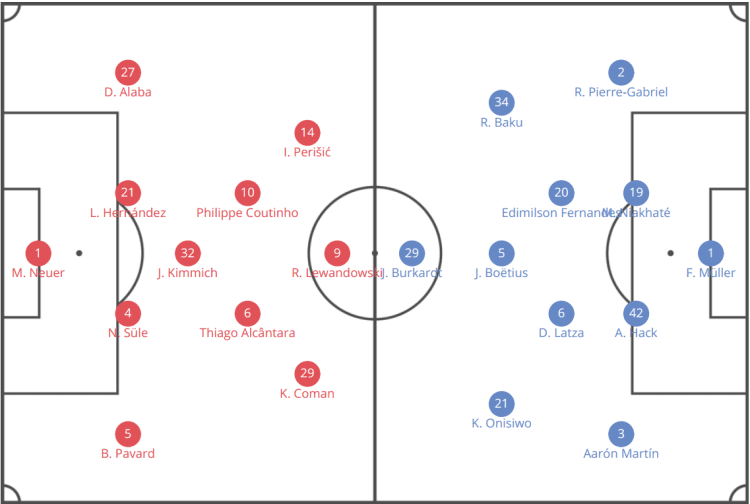
The Croatian coach of Bayern lined his team in a 4-3-3 formation up which was very fluid and versatile as we will see in this analysis. Manuel Neuer was between the sticks and the back four in front of him was made of the two new French signings Benjamin Pavard and Lucas Hernández, as well as Niklas Süle and left-back David Alaba.
Joshua Kimmich played in the defensive midfield and Coutinho was in front of the German together with Thiago Alcântara. On the wing, Ivan Perišić played instead of the not-completely-fit Serge Gnabry. Usually, Kingsley Coman played in recent times on the left wing and Gnabry on the right wing, but since Perišić feels more comfortable on the left one, the Frenchman switched to the right. Lewandowski was as always, the lone striker upfront and was able to score a goal. In light of this, he now already scored six times in the first three games in the Bundesliga.
On the other side, Schwarz used a 4-2-3-1 formation in this match. Florian Müller was the goalkeeper while the back four in front of him consisted of Aarón Martín, Alexander Hack, Moussa Niakhaté, and Ronaël Pierre-Gabriel who joined them during this summer transfer window and made his Bundesliga debut.
Edimilson Fernandes and Danny Latza were the defensive midfielders while Jean-Paul Boëtius was the number 10 behind the 19-year-old lone striker Jonathan Burkardt. The wings were occupied by the Austrian Karim Onisiwo and German Ridle Baku.
Now when you compare the two lineups, two differences get visible. On the one hand of course, Bayern has got more individual quality as the comparison of the market values proves us. The average value of the players in the starting eleven of the Bavarians is £49.75 million while Mainz just reaches a value of £5.99 million. In addition, Schwarz’s starting lineup has got an average age of 23.2 years compared to Bayern’s 27.0. Even after two losses at the beginning of the season, the elimination in the first round of the cup and the fact that they played against the Bayern, Mainz’s couch trusted his young players.
Mainz with a good performance
Especially during the first minutes, Schwarz’s team was very good. In general, they tried to build up their attacks with short passing combinations from the back. This idea got visible when Müller had to take a goal kick. Both centre-backs positioned themselves inside the penalty box or on the edge of it to have at least two short passing options, but Müller also sometimes chose other risky options.
In the image below he plays a pass to the defensive midfielder Fernandes to overcome the first pressing wave of Bayern. The pass was successful, but the Swiss’ first touch wasn’t good and so Coutinho was able to win back the ball for the Bavarians. The Brazilian played immediately a pass to Lewandowski who took a shot from the edge of the box but couldn’t score. This situation already took place in the fourth minute and had, as a result, a dangerous chance for Bayern but Mainz just continued to build up from the back with short passes.
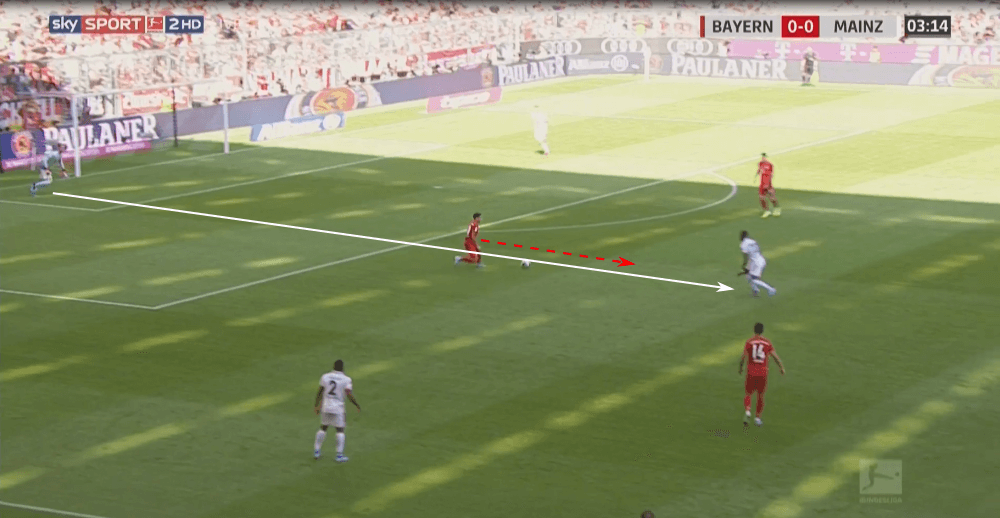
When they were able to get out of their defensive third and stay in possession, they often used a similar and easy pattern. Since the two full-backs, Martín and Pierre-Gabriel are both two very offensive-orientated and have the stamina to support their teammates, they often pushed forward. However, since then they would occupy the same space on the wing as Onisiwo and Baku, those two positioned more centrally in the half-spaces.
Boëtius permanently tried to position in free spaces to create a passing option for the defensive midfielders and the centre-backs. He also had the task of supporting the 19-year-old striker Burkardt up front.
All these mechanisms perfectly worked out in the sixth minute. Baku shifted inside and took Alaba a few meters with him to create space on the wing where right-back Pierre-Gabriel started a forward run. He received a pass from Baku and delivered a great cross. In the centre, Boëtius joined Burkardt who made a run to the first post and Süle followed him which created the space for the Dutchman to score with a great header.
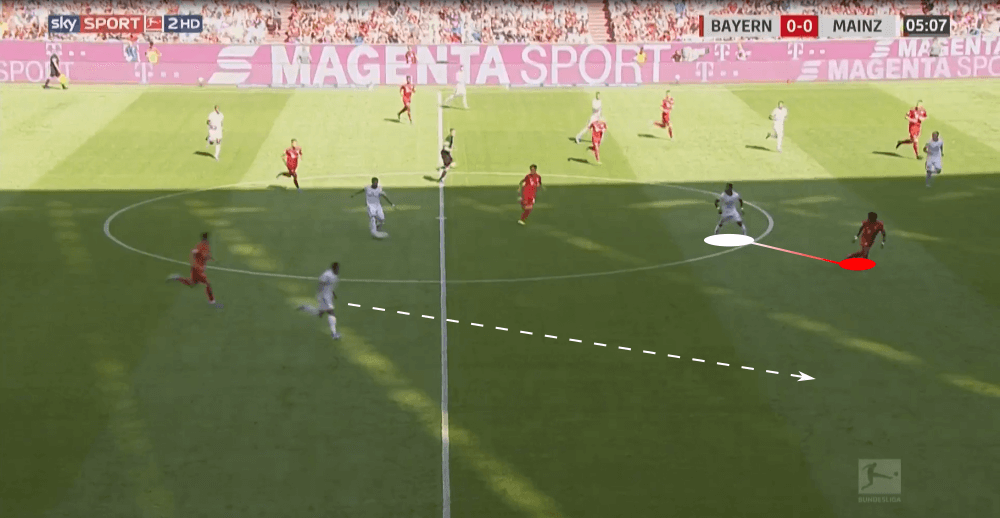
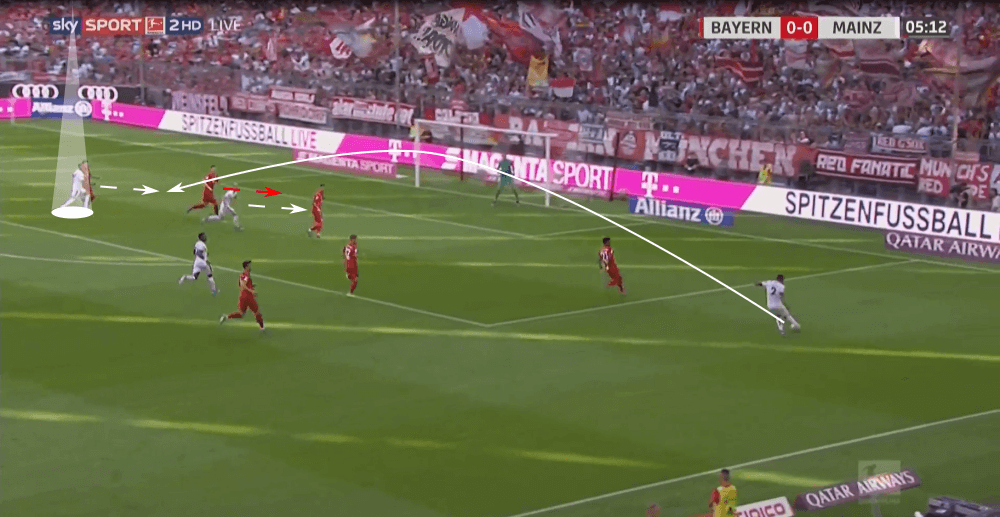
Mainz tried to put pressure on the Bavarians about 10 yards in the opponent’s half. In the first half, they mainly used a 4-4-2 formation and Boëtius together with Burkardt up front. As you can see in the image below, they tried to stay vertical as they were horizontally compact.
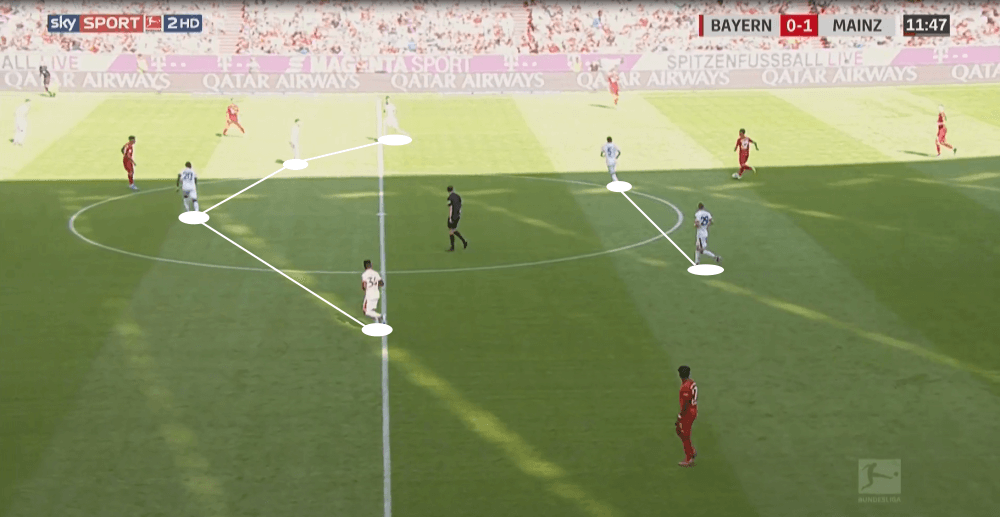
Until Onisiwo got subbed off in the 83rd minute, he had the task of always putting pressure on Kovač’s new right-back and world champion Pavard. Besides that, they tried to avoid Thiago coming that often to the ball and deploy his incredible playmaking qualities. Because of that, Latza often man-marked the Spaniard. Both aspects get visible in the image below. Onisiwo presses in at Pavard while Latza follows Thiago in the centre.
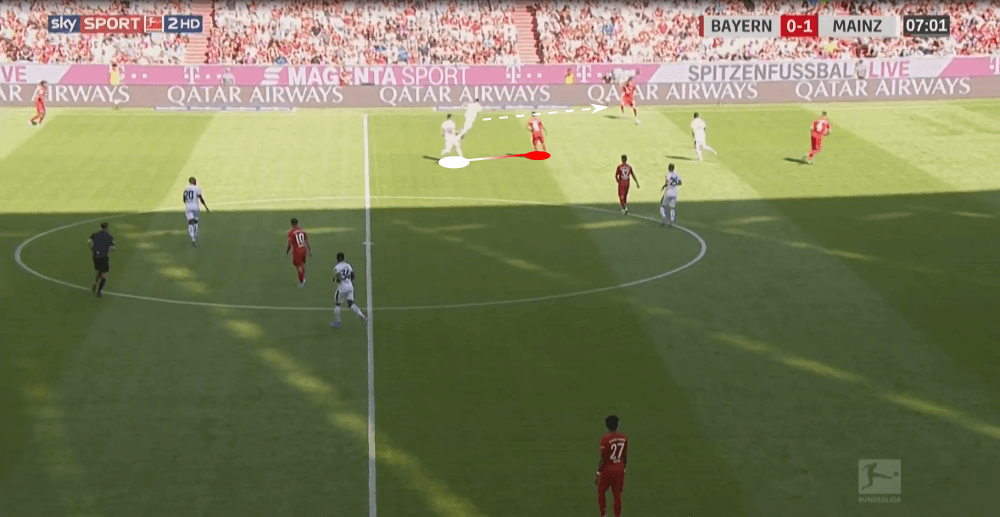
In the second half, Pavard stayed more often deeper to build a back-three with Süle and Hernández as we will see later on, and so Onisiwo also positioned higher during the periods of possession of Bayern. Considering this, their formation turned in some situations to a 4-3-3 with the Austrian as a left-winger, Boëtius in the centre and the young forward Burkardt more on the right. Maybe Schwarz detected Pavard as the weakest spot during Bayern’s build-up.
That’s possible since Süle, Hernández, Kimmich and Thiago are all great passers of the ball and are able to play penetrating forward passes. However, they weren’t able to force the Frenchman to a disastrous mistake since he always stayed calm and found a solution for every problem. 87% of his passes were successful but he didn’t just choose the two easy options to Süle or Neuer. He played 20 forward passes and just four were not completed.
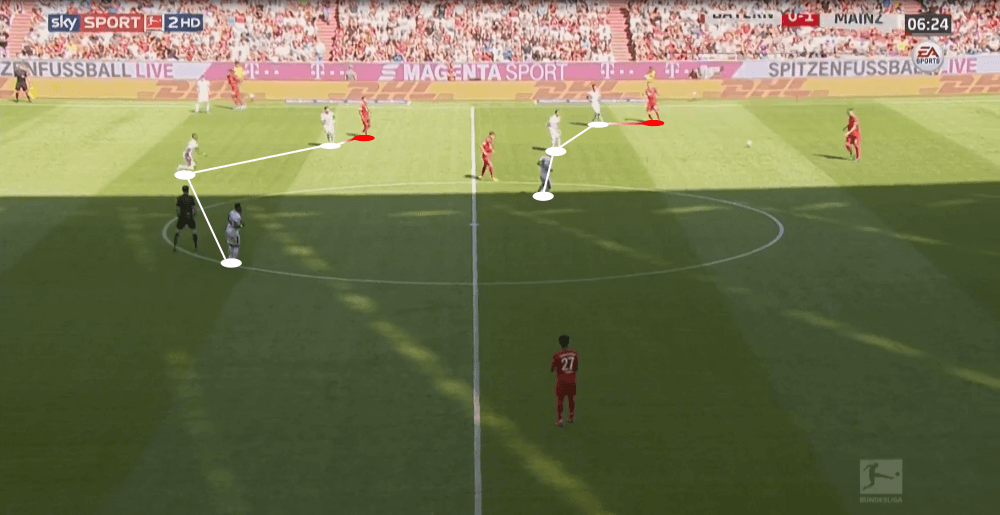
But Mainz wasn’t able to execute such a high midfield-pressing as they did for 90 minutes, especially at the beginning of the game. Due to that, they changed the height of their pressing lane several times during the match. Sometimes they put pressure on the Bavarians as already explained 10 yards in their half and in some situations they sat more back and tried to keep it tight with their two banks of four. And as soon as they won the ball, they immediately tried to start a counter-attack. However, none of their four counter-attacks resulted in a shot.
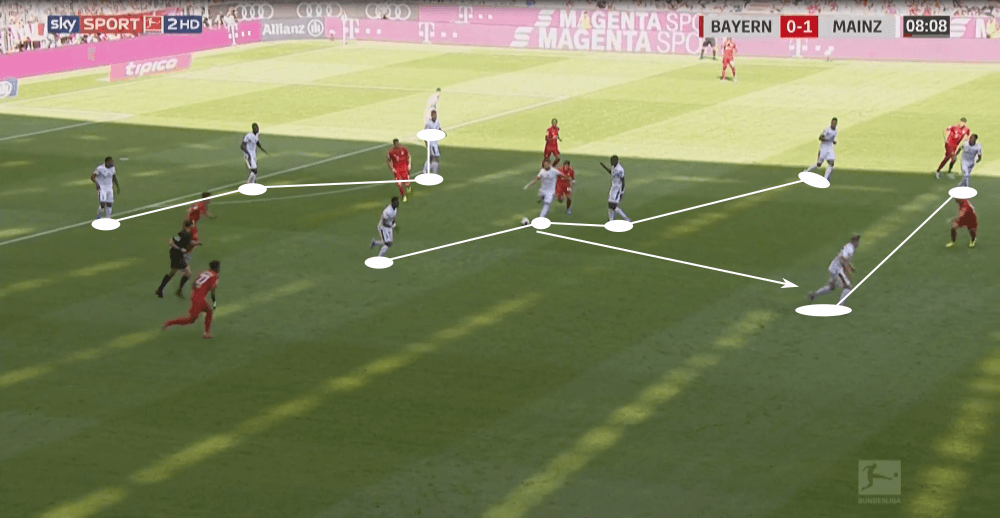
Kovač got what he wanted
A few months ago, the coach of Bayern said that he would like to have more variable players to use different formations and tactics. Except for the two young talents Michaël Cuisance and Fiete Arp who will help Bayern in the future, all four new signings are players who can play in several positions and are very variable. Pavard and Hernández can both play as full-backs as well as centre-backs, and Coutinho and Perišić can play in several offensive positions.
But the transfer of Pavard especially has got another good aspect. Since the world champion can play as a right-back, Kovač has got the option to let the usual right-back choice Kimmich play in central midfield and that’s exactly what he did against Mainz.
Even though Mainz played well and scored an early goal, Pavard was able to score the equaliser in the 36th minute and Alaba scored a beautiful free kick shortly before the break to put Bayern in front. In the second half, they scored four goals and almost all of them, as well as the first two, were a result of individual quality but one tactical aspect was noticeable throughout the game. They were extremely variable and that’s exactly what the coach wanted.
As already explained, they often used a back three during the build-up which consisted of Pavard, Süle and Hernández. Alaba pushed forward very early and Kimmich, as well as Thiago, in the centre. Kimmich mostly stayed a bit deeper and the Spaniard joined Coutinho in a higher line.
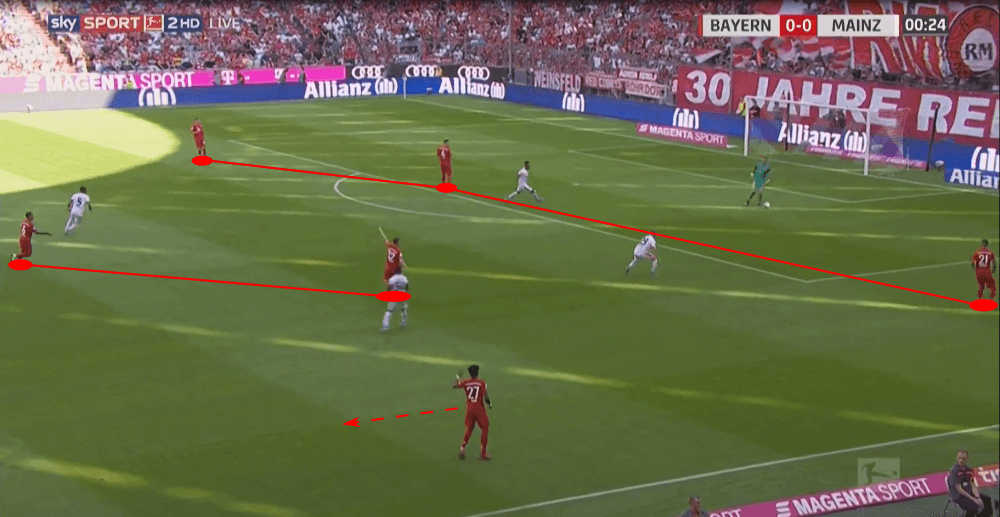
However they also used the pattern which they mostly utilised when Kimmich was played as right-back, and Thiago was the single number six in front of the defence. Both full-backs pushed forward, the centre-backs positioned wider and the Spaniard positioned a bit deeper to either create a back three or to some kind of a triangle.
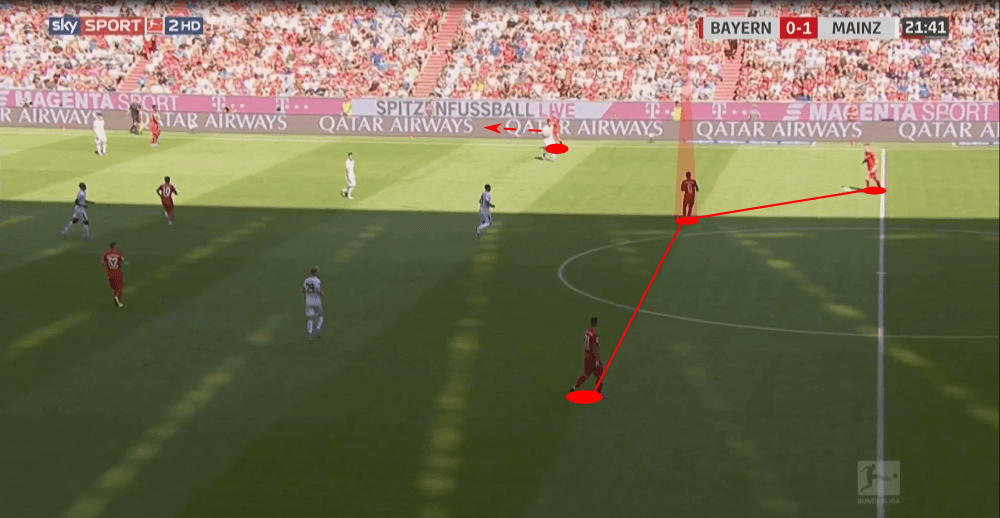
As mentioned before, Mainz focused on putting pressure on Pavard. Even though it didn’t work out that good, the idea was right when we look at the statistics of the five players who were responsible for Bayern’s build-up. He had by far a worse success rate of passes compared to the other four players. His success rate was 87% while the other ones all had a higher one than 93%. Besides, only Thiago completed fewer forward passes but you have to consider that he was most of the time the receiver of such forward passes in a higher position. Of course, these statistics also show that Mainz especially tried to force him to do mistakes and his performance was still good, but he needs to work on his passing abilities if he wants to be a regular part of the starting eleven.
However, Bayern wasn’t just variable when they were in possession but also used different formations and tactics when the opposition were on the ball. Sometimes the Bavarians used a 4-1-4-1 with Kimmich as the lone man between the two lines. Although they often positioned themselves in a 4-4-2 with Coutinho and Lewandowski up front and used a similar pressing height as Mainz did.
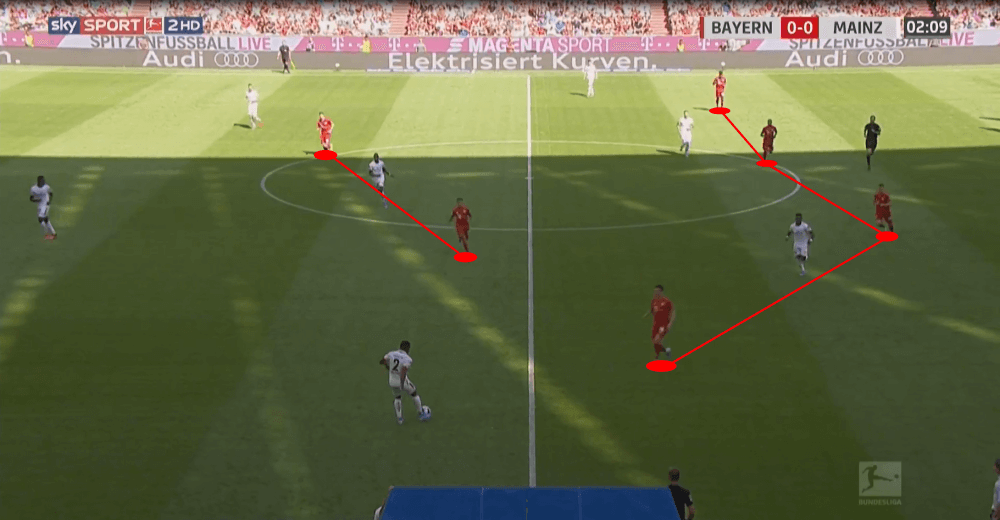
But as you would expect from a top team like Bayern, they also often put pressure on their opponents higher up the pitch. As already shown in the first example in this analysis when Müller played a risky and short goal kick, Mainz tried to build-up their attacks with short passes and so the Bavarians had several opportunities to press in at Schwarz’s team.
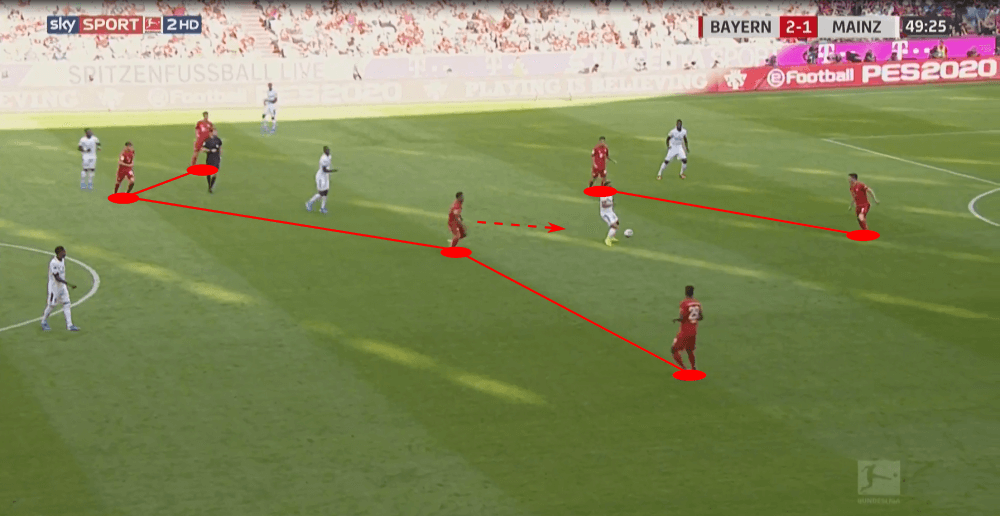
Conclusion
Due to the incredible flexibility of Bayern paired with their individual class, it was a tough game for Mainz who didn’t play as bad as the result suggests. As soon as they have more training sessions together, this fluidity in and out of possession could really be a key factor for them this season.
On the other side, Mainz has got zero points after the third matchday and conceded 12 goals. The team didn’t play that bad in these three games, but they need to win points as fast as possible.
Mainz will face Hertha BSC Berlin after the international break, who just got one point so far. In light of this, this could be a good chance for Mainz to get their first points in this Bundesliga season. Bayern will play away from home against the current leader RB Leipzig- this could show us how good Bayern really is at this early stage of the season.

If you love tactical analysis, then you’ll love the digital magazines from totalfootballanalysis.com – a guaranteed 100+ pages of pure tactical analysis covering topics from the Premier League, Serie A, La Liga, Bundesliga and many, many more. Buy your copy of the August issue for just ₤4.99 here.

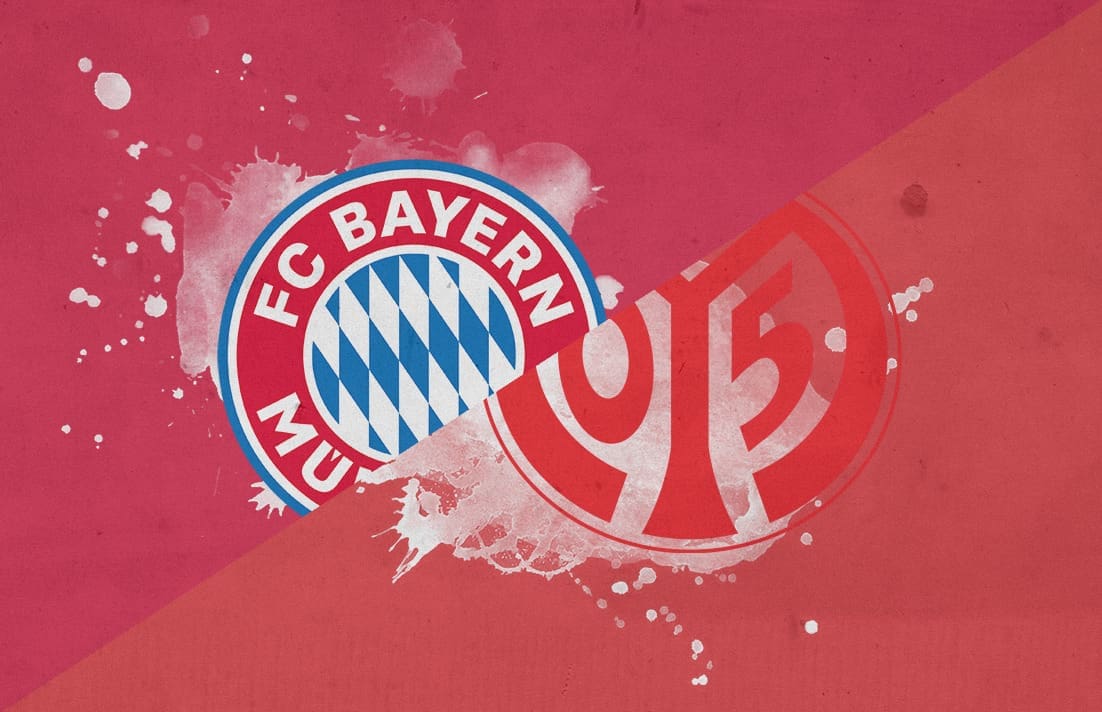



Comments